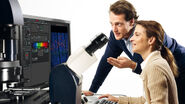X2Y scanner design
The tree-mirror concept is known as the “x2y-scanner”. This approach solves the general problem of scanner systems with two mirrors which cannot be placed in the correct position (the back focal plane) at the same time without additional relay optics. Usually, deviations are accepted by compromising the homogeneity of illumination, with negative effects on uniformity of brightness and resolution. A single mirror solution (gimbal/cardanic mounts) offers homogeneous illumination, but is restricted to very low scanning speeds.
The x2y scanner illuminates the full field of view homogeneously and allows high scanning speed. This scanning concept also allows the x-mirror to be exchanged by moving the alternative mirror (either conventional or resonant) into the proper position.
Annotation
- Be careful not confuse it with the spinning-disc-type tandem scanner developed in the 1960s by Petran et al.: M. PETRÁŇ; M. HADRAVSKÝ; M.D. EGGER; R. GALAMBOS (1968), "Tandem-Scanning Reflected-Light Microscope", Journal of the Optical Society of America (JOSA), 58 (5): 661–664, DOI: 10.1364/JOSA.58.000661.





